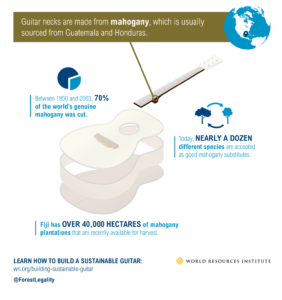No products in the cart.
Blog
Mahogany is the most Popular Choice of Tonewoods
Mahogany is the most popular choice of tonewoods for guitar backs and sides, though it’s also occasionally used as a top material. Mahogany is a dense wood, with a dark finish, and close grain. Tonally, it has far warmer, darker tone than both Cedar and Spruce.
As a material for back and sides, mahogany’s density can add great ‘punch’ and projection, adding warmth, but with definition, and a ‘woody’ character.
The combination of spruce and mahogany is one of the most popular, because it offers a tone that sounds very balanced, yet versatile, lending itself very well to many musical styles.
This is our fourth installment about the future of tonewoods; the woods used in guitars and other musical instruments. In each installment, we look at a different species of tree used for a certain part of the guitar. Previous installments include Spruce, KOA and Ebony. Each wood presents its own challenges and possibilities surrounding sustainable harvest.
 A guitar is useless unless it plays perfectly. Even the most beautiful woods can’t make up for poor construction, and the materials chosen ultimately have to serve a practical use. One of the most important parts of the guitar is the neck, which has to stay absolutely stable and straight over many years. If the neck bows too far in one direction or the other, the instrument becomes unplayable. The best guitar necks are made of mahogany. The reddish-brown wood has an interlocking grain that makes it especially resilient to changes in humidity and temperature, which would cause many other woods to shift over time.
A guitar is useless unless it plays perfectly. Even the most beautiful woods can’t make up for poor construction, and the materials chosen ultimately have to serve a practical use. One of the most important parts of the guitar is the neck, which has to stay absolutely stable and straight over many years. If the neck bows too far in one direction or the other, the instrument becomes unplayable. The best guitar necks are made of mahogany. The reddish-brown wood has an interlocking grain that makes it especially resilient to changes in humidity and temperature, which would cause many other woods to shift over time.
What Is Mahogany?
Genuine mahogany (Swietania macrophylla) is native to Central and South American rainforests and takes a spotlighted stand in the colonial history of that region. Designers like Thomas Chippendale brought fine mahogany furniture to Europe and the exotic timber caught the world by storm. The wood became such a part of Central American history that the flag of Belize still features two loggers underneath a mahogany tree.
While mahogany has a long colonial history, its sharp decline in availability started in the 1950s as demand from the growing American middle class skyrocketed. At that time, guitar companies saw their market grow exponentially, but they also saw their costs rise as high-quality mahogany became even scarcer.
Between 1950 and 2003, over 70 percent of the world’s genuine mahogany was cut. This prompted CITES – the Convention on International Trade in Endangered Species – to finally protect mahogany by restricting trade. In light of this regulation, manufacturers took two approaches to meet demand:
a. Use more plentiful alternatives to genuine mahogany
b. Support sustainable community forestry in Central America
African Alternatives?

Today, the term “mahogany” encompasses a wide range of tree species that span the globe. Each of these species is equally equipped for instrument making. Woods from the Khaya genus, native to the Congo Basin and Western Africa, are now as common on guitars as genuine mahogany from Central America. African alternatives are relatively cheap and abundant and the available wood is often found equal or superior to the Central American trees. These woods resemble their Central American counterparts in both form and function, but grow so quickly that they can meet demand without severe threats to the environment. Likewise, plantations in Fiji are now supplying large amounts of quality mahogany, but at a sustainable pace.
Making a Future in Central America
Many guitar makers have taken a stand to support sustainable community forestry programs in Central America as well. Martin Guitars supports sustainable mahogany from several concessions and has embraced Forest Stewardship Council (FSC) and Rainforest Alliance certification. Martin even offers instruments that exclusively use FSC-certified woods. These external audits help Martin maintain high environmental standards while also reassuring consumers about their purchase. Gibson Guitars is also a large proponent of FSC-certified mahogany as an effective tool for businesses to promote sustainable use and impact local livelihoods.
Tom Bedell of Bedell and Breedlove Guitars, for example, sources mahogany exclusively from a well-respected concession in the Peten Region of Guatemala. Since their founding over 15 years ago, these areas have had a deforestation rate of nearly zero. Taylor Guitars relies largely on cooperatives in Honduras for sustainable and legal mahogany. Selective harvesting from community forest concessions in Guatemala and Honduras enables the production of fine guitars while contributing to local livelihoods and combatting illegal logging. In the video Tom Bedell shows a little bit about the process.
The guitar industry has set a great example with mahogany. Manufacturers are taking serious measures to harvest sustainably and to combat illegal logging. In the process, they are increasingly helping local communities build industry and prosperity. Illegal logging is ultimately bad for everyone, and guitar manufacturers are investing in long-term solutions to the problems that cause it. As consumers, we can show our support for forests through our purchases. Luckily, this tonewood has success stories in the making, but now the onus is on consumers to make informed choices when they buy instruments.
Forests around the world — including those that provide tonewoods for musical instruments — face threats of illegal logging and over-harvesting. The guitar industry has already proven its ability to shift supply chains and to offer a more sustainable and transparent product. Now, the pressure for change must come from informed, conscious consumers.

